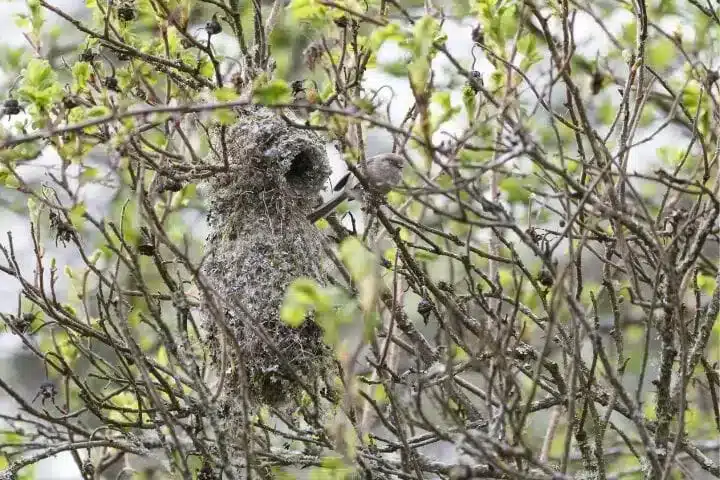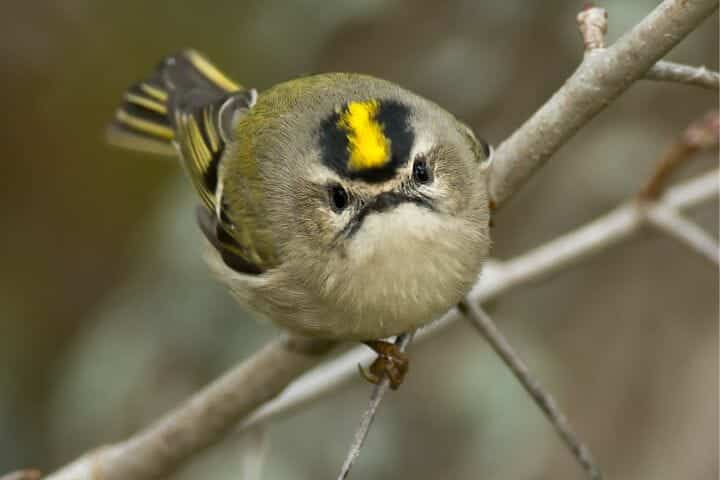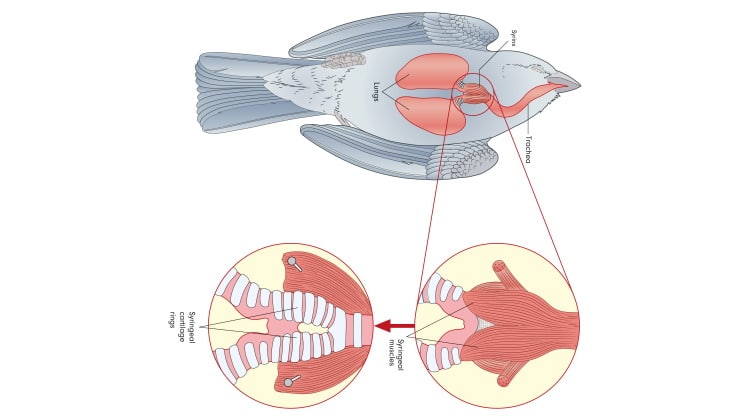10 Birds That Build Hanging Nests
10 Birds That Build Hanging Nests That Defy Gravity
What’s that hanging set of twigs on a tree branch? Chances are, you are seeing a hanging nest. Let’s look at ten birds that build hanging nests and why they build their nests in this peculiar way.
Although there are a wide variety of bird nests, one of the most intriguing styles is the hanging nest. In fact, some of these nests hang down so low that they seem to be defying gravity!
For example, take the Altamira Oriole, a native of southern Texas, Mexico, and parts of the central US.
Made from plant rootlets that have air trapped inside them, these nests have a lining inside made of horse hair and palmetto fiber. The Alta Mira Oriole’s nests are more than two feet long.
These tiny birds design their nests in ways that reduce their weight while still being durable enough to hold the bird’s eggs and hatchlings later on.
We look at some more of these marvels of engineering that the bird species create in the article below.
1. The American Bushtit
The American bushtit is native to the Western US, the great basin, California, extending in the south towards Mexico & even Guatemala, and up to Vancouver in the north.
You can normally find these tiny, sparrow-like birds within woodlands and scrublands.
However, with the human population increasingly impinging upon their natural homes, these birds are now to be found in parks and gardens too.
These birds are very chirpy and forage for their food in groups, continuously calling each other as they hunt.

These birds start making their nests in the springtime, like most others. You will find both the male and female working away industriously, looking for a suitable site where they can hang their pendulous nests.
The site can be as high as 100 ft up or as low as just 3ft from the ground.
Once they decide on a suitable site, they will start building the nest with materials like lichens, spider silk, and moss for the nest’s exterior.
On the inside, they lay down feathers and fur to make a soft lining comfortable for their offspring. It may take them up to a month to build a nest.
Their nests hang about a foot down from the site at which they start making it.
The nest is stretchy, and sometimes other adult bushtits will sit down in the nest while the to-be mom and pop bushtit is making it, just to stretch it further downwards and make space for the eggs and nestlings.
An interesting thing about bushtit nests is their perfect camouflage: they use plant material on the exterior to blend the nest into its surroundings (when they build the nest on a tree branch).
They also make a false entrance at the top to fool predators, whereas the actual entrance is often on the side and hidden by plant material.
Bushtits breed twice a year and typically use the same nest both times. In one brood, they might have about 4-10 eggs, which hatch in 11-13 days and fly away in another fortnight.
At the height of this activity, all the birds involved – the parents, helper adults, and the babies all live inside the nest. You can often see their nest bustling with activity at such times.
2. Montezuma Oropendola
The Montezuma Oropendola is a tropical bird. It is native to coastal lowlands, old plantations, and forest canopies in the Caribbean, central Panama, and southeastern Mexico.
Their nests are among the most densely populated pieces of avian real estate in the world. Each colony contains as many as 24 birds nesting, and one particular colony was recorded with 172 nests!
Each hanging nest is anywhere between 24 to 40 inches tall. These birds make their nest from fibers and vines, which makes the nest elastic and stretch downwards. Their mating and nesting season usually runs from January to May.

You can see the Montezuma’s nests from the coastline, hanging like fruits from trees. These nests are about 30m above the ground. Only females build nests in this species.
Each colony has a single, dominant male who mates with all of these female birds. The dominant male bird wards off the challenge from other male birds and establish dominion over a nest. When the alpha male leaves, other males do the job of protecting the females.
Each bird lays only two eggs in a clutch, and
There are two eggs in a latch, and both males and females incubate the eggs. It takes 15 days for the eggs to hatch, and in 30 days, the chicks fledge.
3. Warbling Vireo
The warbling vireo is a songbird native to North America. Their breeding ground is Florida, Mexico, and Alaska, and they migrate to Central America and Mexico during winters.
Warbling vireos breed from May to august. They make their nests on deciduous trees anywhere between 3 to 140 feet high from the ground.
Their nests are in a hanging cup shape. Each nest is about 3 inches in diameter and 3 inches in height.
They choose twigs that have forked arms to hang two ends of the nest, making their nests look conical at times.

Warbling vireos make nests from easily available materials in their habitats, such as moss, twigs, and lichens. They also use plant matter and cobwebs to weave the nest together.
The nests are made mostly by females. A trick that they use to build their nests quicker is to steal materials from other birds.
Warbling vireos can breed once or twice a year, and they incubate their eggs for about 12-14 days.
4. Golden-Crowned Kinglet
Golden-crowned kinglets are small songbirds belonging to the family of Regulidae, which are native to most of North America.
Kinglets construct their nest at a very high location – almost 60 to 100 feet from the ground. They nest in remote areas, primarily boreal coniferous forests and montane groves or wooded bogs.
Both female and male Golden-crowned Kinglets help in building the nest. The nest is in a cup shape with four corners, attaching each corner to a twig. Nesting season typically starts in the first week of May.
Sometimes the nest might be fully suspended in the air, or on other occasions, they build nests that are resting on other twigs.

Their nest size is 3 inches in diameter and about 2-3 inches tall. They build these nests with materials such as spiderwebs, insect cocoons, lichens, mosses, and plant materials. The inner lining of the nest includes feathers and deer hair.
The nests are elastic and can hold chicks for a long time before they learn to fly out.
Both male and female birds care for the eggs and nestlings. It takes about 14-15 days for the eggs to hatch and a further 19 to 24 days for the chicks to be able to fly.
5. Baya Weaver
The baya weaver builds one of the most beautiful and intricate hanging bird nests in the world. These birds are native to southeast Asia, especially the Indian subcontinent.
These sociable weaver birds build nests by using paddy leaves, strips of palm fronds, and rough grasses. These strips of palm fronds are quite large, some as large as 24 inches.
To complete a weaver bird nest, the weaver bird can make as many as 500 trips to and fro, just gathering strips.
Baya weavers breed during the monsoon season. Male and female baya weavers are polygamous, but surprisingly, it is the male who builds the nest.

In fact, the beautiful nests that we see are not for nesting. These are just beautiful pieces of art that the male uses to attract the female bird.
The female chooses her mate based on his proficiency at making the nest, its durability, location (how tall a branch it is on), and other factors.
Once she finalizes a mate, she is the one who actually completes the nest by laying down feathers and other softer materials to make the nest ready for the babies.
Baya weavers lay about 2-4 eggs in each breeding season. The female sits on the eggs to incubate them for 14-17 days. After hatching, both female and male birds feed the offspring. The chicks fledge after another 17 days.
6. Purple-Rumped Sunbird
Another bird that builds a hanging bird nest is the purple-rumped sunbird. It is native to the Indian Subcontinent and Australia.
These birds live in trees but not in dense forests. The nests are constructed by the female purple-rumped sunbirds, with the male playing no part.
She uses cobwebs, plant fibers, bark pieces, seeds, lichens, and other nest materials to build pouch-like nests.
She then lines the inside of the nest with fuzz from the Calotropis seeds to make the nest comfortable. She places the nest on a branch end, with its entrance facing a bush.

Sometimes, purple-rumped sunbirds might also build their nest on porches or nearby buildings. These birds do not immediately start laying eggs once they make their nest.
When it is time to lay eggs, the female birds come back to the nest that she built.
The purple-rumped sunbird produces only two eggs at once. Both the female and male of the species incubate the eggs for about 14 to 16 days.
Their chicks then take another 17 days to grow and ultimately fly away. These birds sometimes reuse old nests during their next breeding season.
7. Common Firecrest
Common firecrests, or just firecrests, are passerine birds belonging to the kinglet family. These birds breed in northwestern Africa and temperate Europe. The Firecrests in northern and western Europe migrate to the south during the winters.
The common firecrest’s nest is compact. It has a diameter of about 3.1 inches and is about 2.8 inches tall. The thickness of the wall is around 2 inches.
The firecrest build nests that have three layers. The nest usually hangs about 2.5 meters to 20 meters from the ground.

The outer layer of the nest contains twigs, moss, lichen and cobwebs, and spider webs to support the nest.
In the middle layer, there is moss, and the inner layer contains feathers to make the nest comfortable for the would-be hatchlings.
The common firecrest lays about 7-12 eggs in each clutch. The female bird incubates the eggs. The eggs hatch after around 14.5-16.5 days and fledge after another eight to ten days.
Both male and female birds feed their offspring.
8. Warbling White-Eye
The warbling white eye is another bird that builds hanging nests. These birds are native to Korea, Japan, eastern china, northern Philippines, and Taiwan. They migrate to Thailand, Vietnam, Burma, and Hainan Island during the winters.
A pair of warbling white eyes build their nests together. They hang the nest at the height of about 100 feet from the ground.
These birds take about seven to ten days to complete their nest. They use various materials for building their nest ranging from moss, spider webs, mammal hair, and lichens.

Apart from collecting the materials, the warbling white eyes also steal materials from other birds. They make nests in the shape of a cup. Each nest is about 1.7 inches in diameter and 2.2 inches in height.
Mostly, white eyes use their nest only once. However, these birds do breed in three clutches. Therefore, in some cases, they may use the nest as many as three times during a single season.
A clutch of warbling white eyes can contain about two to five eggs. Both males and females incubate the eggs. It takes them about 11-12 days to hatch.
The offspring take another 11-12 days to fledge; after that, they remain with their parents for another 15-20 days before they fly off on their own.
9. Goldcrest
Goldcrest birds are also from the kinglet family, just like the common firecrest. They belong to Europe, but several subspecies reside in the Himalayan regions and other Asian countries as well.
Goldcrests are the smallest birds in Europe, weighing in at about a quarter pound and measuring about 3 inches in length.
These birds mainly breed and live in mountainous woodlands with coniferous trees. They usually hang their nests on branches of conifers. After breeding season, they move on to shrubs and deciduous trees.

Goldcrests build three layered hammock-styled spherical nests. They use moss, lichens, and spider webs to build the outer and middle layers of the nest.
Then, they line the nest with feathers on the inner layer to make them more comfortable for their offspring.
These birds hang their nests close to the ground. Their nests are around 3.5 inches in diameter from the inside. They can hang anywhere from 3 to 72 feet above the ground.
Goldcrests lay about six to thirteen eggs in one clutch. Female goldcrests incubate the eggs, and it takes about 16 to 19 days for them to hatch. They fledge in another 17 to 22 days.
10. Eurasian Golden Oriole
Eurasian golden orioles are part of the family of passerine birds. They breed in temperate regions of the northern hemisphere.
These birds migrate to Europe during the summers and spend their winters in central and southern Africa.
Nest making in the golden orioles begins with the male of the species collecting the materials. However, it is the female who builds the nest.
They build their nests in a pensile (open cup) shape. Their nest can be anywhere from 1 to 5 inches tall. Orioles use sedges, woven grass, reeds, and twigs to build their nest.

They line their nests with fur, feathers, moss, or wool to make the insides comfortable for their hatchlings.
The golden oriole’s clutch can have three to five eggs. Most of the time, females incubate eggs. However, when the females go out to collect feeding materials, the males also help to incubate the eggs.
It takes 16 to 17 days for the eggs to hatch, and they learn to fly in another 16 to 17 days.
Another oriole bird species to build hanging nests is the Baltimore oriole. You will find their nests hanging on American elms and maples below a branch. They also hang their nests by anchoring it to a tree trunk.
The nesting material can include a variety of things, including grass, wool, grapevine bark strips, and man-made things such as cellophane. Baltimore orioles prefer to rebuild their nests over older ones.
The Baltimore oriole lays just one brood a year, with each brood having about three to seven eggs. The eggs hatch in about 11 to 14 days, and the hatchlings take the same amount of time to learn to fly.
Wrap Up
Hanging nests are a sight to behold because they put the delicate artistry and the birds’ unique understanding of building homes on display.
Unlike normal cup-shaped nests, hanging nests are usually easy to spot, and in many cases, the birds want others to see them (for example, in the case of the baya weaver).
While we have singled out ten birds who make hanging nests, there are many others who also partake in this wonderful style of nest making.




